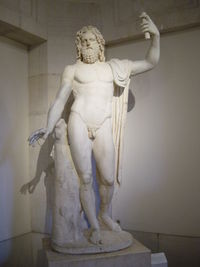Capitoline Triad
2007 Schools Wikipedia Selection. Related subjects: Divinities
The Capitoline Triad was a group of three supreme deities in Roman religion who were worshipped in an elaborate temple on Rome's Capitoline Hill, the Capitolium. Two distinct Capitoline Triads were worshipped at various times in Rome's history, both originating in ancient traditions predating the Roman Republic, but the more recent, consisting of Jupiter, Juno and Minerva and drawing heavily from Etruscan mythology, is the one most commonly referred to as the "Capitoline Triad". The earlier, more traditional Indo-European-derived triad, now known as the Archaic Triad, consisted of Jupiter, Mars and Quirinus. Both groups of deities were central to Roman worship during their respective apices of popularity.
Archaic Triad
The original three deities thus worshipped, now more commonly referred to as the Archaic Triad, were Jupiter, Mars and Quirinus. Jupiter was the supreme ruler of the heavens and god of thunder, Mars the god of agriculture and guardian of crops, and later a war deity, and Quirinus the enigmatic god of the Roman populus ("people").
This grouping has been interpreted as a symbolic representation of early Roman society, wherein Jupiter, standing in for the ritual and augural authority of the Flamen Dialis (high priest of Jupiter) and the chief priestly colleges, represents the priestly class, Mars, with his warrior and agricultural functions, represents the power of the king and young nobles to bring prosperity and victory through sympathetic magic with rituals like the October Horse and the Lupercalia, and Quirinus, with his source as the deified form of Rome's founder Romulus and his derivation from co-viri ("men together") representing the combined military and economic strength of the Roman people.
According to Georges Dumézil's controversial trifunctional hypothesis, this division symbolizes the overarching societal classes of "priest" (Jupiter), "warrior" (Mars) and "farmer" or "civilian" (Quirinus). Though both Mars and Quirinus each had militaristic and agricultural aspects, leading later scholars to frequently equate the two despite their clear distinction in ancient Roman writings, Dumézil argued that Mars represented the Roman gentry in their service as soldiers, while Quirinus represented them in their civilian activities. Although such a distinction is implied in a few Roman passages, such as when Julius Caesar scornfully calls his soldiers quirites (" citizens") rather than milites ("soldiers"), the word quirites had by this time been dissociated with the god Quiritus, and it is likely that Quiritus initially had an even more militaristic aspect than Mars, but that over time Mars, partially through synthesis with the Greek god Ares, became more warlike, while Quiritus became more domestic in connotation. Resolving these inconsistencies and complications is difficult chiefly because of the ambiguous and obscure nature of Quirinus' cult and worship; while Mars and Jupiter remained the most popular of all Roman gods, Quirinus was a more archaic and opaque deity, diminishing in importance over time.
Later Triad
The three deities who are most commonly referred to as the "Capitoline Triad" are a group that supplanted the original Archaic Triad. This group, mirroring the Etruscan divine triad, consisted of Jupiter, the king of the gods, Juno (in her aspect as Iuno Regina, "Queen Juno"), his wife and sister, and Jupiter's daughter by the titaness Metis, Minerva, the goddess of wisdom.
Unlike the earlier Archaic Triad, which was fairly typical of a trio of supreme divine beings, this grouping of a male god and two goddesses was highly unusual in ancient Indo-European religions. It is almost certainly derived from the Etruscan trio of Tinia, the supreme deity, Uni, his wife, and Menrva, their daughter and the goddess of wisdom.
Capitolium

Jupiter, Juno and Minerva were honored in temples known as Capitolia, which were built on hills and other prominent areas in many cities in Italy and the provinces, particularly during the Augustan and Julio-Claudian periods. Most had a triple cella. The earliest known example of a Capitolium outside of Italy was at Emporion in Spain.
Although the word Capitolium (pl. Capitolia) could be used to refer to any temple dedicated to the Capitoline Triad, it referred especially to the temple on the Capitoline Hill in Rome known as aedes Iovis Optimi Maximi Capitolini ("the temple of the Best, Greatest, Capitoline Jupiter"). The temple was built under the reign of Lucius Tarquinius Superbus, the last King of Rome prior to the establishment of the Roman Republic. Although the temple was shared by Jupiter, Juno and Minerva, each deity had a separate cella, with Juno Regina on the left, Minerva on the right, and Jupiter Optimus Maximus in the middle. It included a podium and a tetrastyle (four column) pronaos (porch).
Another shrine ( sacellum) dedicated to Jupiter, Juno Regina and Minerva was the Capitolium Vetus on the Quirinal Hill. It was thought to be older than the more famous temple of Jupiter Optimus Maximus on the Capitoline Hill, and was still a landmark in Martial's time, in the late 1st century.
